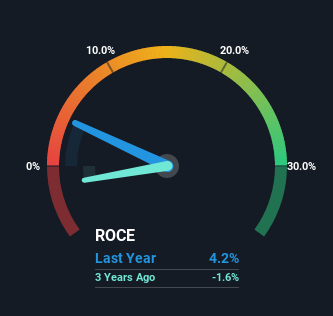- India
- /
- General Merchandise and Department Stores
- /
- NSEI:VAKRANGEE
The Returns On Capital At Vakrangee (NSE:VAKRANGEE) Don't Inspire Confidence
There are a few key trends to look for if we want to identify the next multi-bagger. Ideally, a business will show two trends; firstly a growing return on capital employed (ROCE) and secondly, an increasing amount of capital employed. If you see this, it typically means it's a company with a great business model and plenty of profitable reinvestment opportunities. In light of that, when we looked at Vakrangee (NSE:VAKRANGEE) and its ROCE trend, we weren't exactly thrilled.
Return On Capital Employed (ROCE): What Is It?
If you haven't worked with ROCE before, it measures the 'return' (pre-tax profit) a company generates from capital employed in its business. To calculate this metric for Vakrangee, this is the formula:
Return on Capital Employed = Earnings Before Interest and Tax (EBIT) ÷ (Total Assets - Current Liabilities)
0.042 = ₹1.1b ÷ (₹29b - ₹1.8b) (Based on the trailing twelve months to June 2022).
Therefore, Vakrangee has an ROCE of 4.2%. Ultimately, that's a low return and it under-performs the IT industry average of 11%.
Check out our latest analysis for Vakrangee

While the past is not representative of the future, it can be helpful to know how a company has performed historically, which is why we have this chart above. If you want to delve into the historical earnings, revenue and cash flow of Vakrangee, check out these free graphs here.
What The Trend Of ROCE Can Tell Us
In terms of Vakrangee's historical ROCE movements, the trend isn't fantastic. Around five years ago the returns on capital were 45%, but since then they've fallen to 4.2%. Although, given both revenue and the amount of assets employed in the business have increased, it could suggest the company is investing in growth, and the extra capital has led to a short-term reduction in ROCE. And if the increased capital generates additional returns, the business, and thus shareholders, will benefit in the long run.
What We Can Learn From Vakrangee's ROCE
In summary, despite lower returns in the short term, we're encouraged to see that Vakrangee is reinvesting for growth and has higher sales as a result. But since the stock has dived 85% in the last five years, there could be other drivers that are influencing the business' outlook. Regardless, reinvestment can pay off in the long run, so we think astute investors may want to look further into this stock.
On a final note, we found 2 warning signs for Vakrangee (1 doesn't sit too well with us) you should be aware of.
For those who like to invest in solid companies, check out this free list of companies with solid balance sheets and high returns on equity.
New: Manage All Your Stock Portfolios in One Place
We've created the ultimate portfolio companion for stock investors, and it's free.
• Connect an unlimited number of Portfolios and see your total in one currency
• Be alerted to new Warning Signs or Risks via email or mobile
• Track the Fair Value of your stocks
Have feedback on this article? Concerned about the content? Get in touch with us directly. Alternatively, email editorial-team (at) simplywallst.com.
This article by Simply Wall St is general in nature. We provide commentary based on historical data and analyst forecasts only using an unbiased methodology and our articles are not intended to be financial advice. It does not constitute a recommendation to buy or sell any stock, and does not take account of your objectives, or your financial situation. We aim to bring you long-term focused analysis driven by fundamental data. Note that our analysis may not factor in the latest price-sensitive company announcements or qualitative material. Simply Wall St has no position in any stocks mentioned.
About NSEI:VAKRANGEE
Vakrangee
A technology company, provides e-commerce, white label ATM, financial, and logistics services in India.
Flawless balance sheet with proven track record.
Similar Companies
Market Insights
Community Narratives



